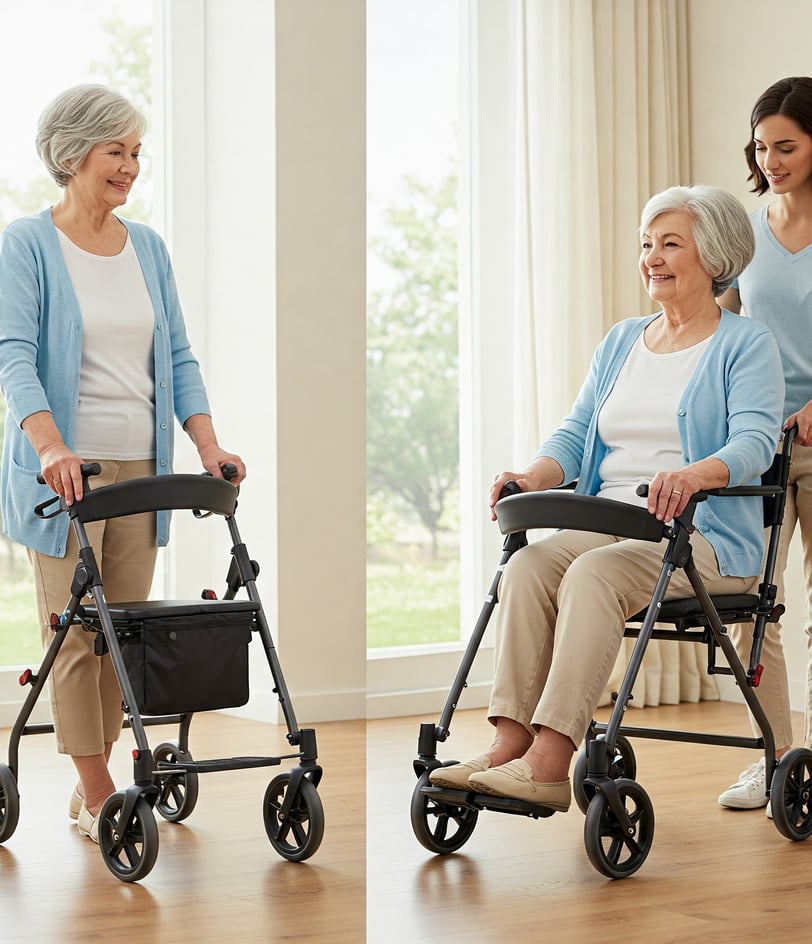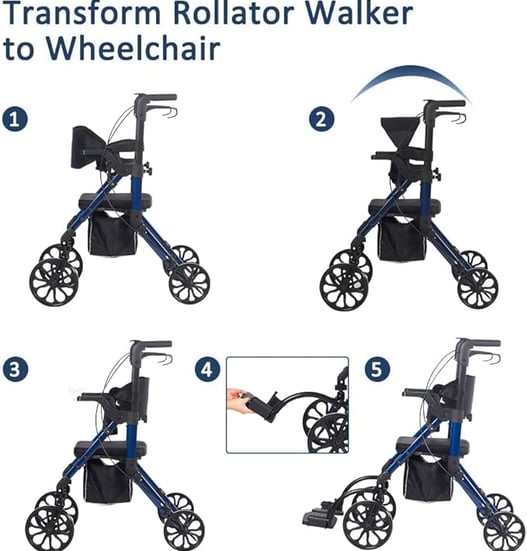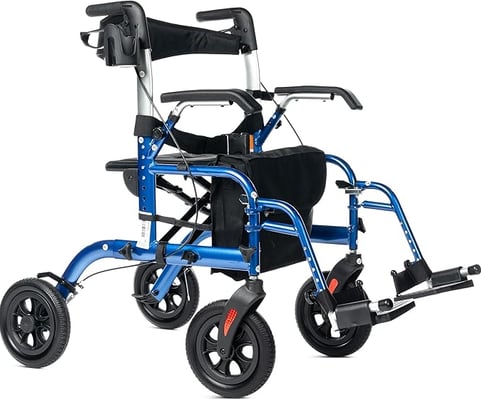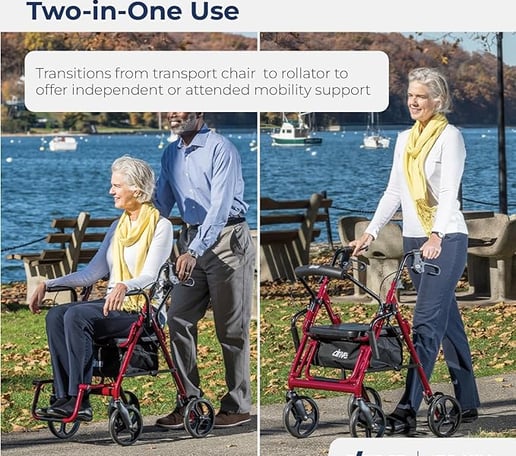Can a Rollator be Used as a Wheelchair?
We will explain the difference between a 2-n-1 rollators and wheelchairs.
5/11/20259 min read


Can a Rollator Can Be Used As a Wheelchair: Understanding the Differences and Limitations
Rollators and wheelchairs are both important mobility aids that help people get around. Many people wonder if a rollator can do double duty as a wheelchair when needed. This question often comes up when someone is considering which mobility device to purchase or when they need temporary seated mobility.
A rollator cannot fully replace a wheelchair because it's not designed for someone to "wheel" themselves while seated. While most rollators have a seat, this feature is intended for short rest breaks rather than continuous transportation. The seats typically lack proper support and safety features that wheelchairs provide.
However, you might consider a transport chair or rollator-wheelchair hybrid if you need both walking support and occasional wheeled mobility. These specialized devices offer features of both mobility aids while being more portable than a standard wheelchair. They allow for more flexibility in different situations while still providing adequate support.
Up to 30% Off: 3 Reasonably Priced Best Sellers, 2 in 1 Rollators are pictured below and can be purchased on Amazon by clicking the pictures or blue links.
*Most single use rollator seats are designed for temporary rest breaks, not extended seated transportation like wheelchairs.
* Transport chairs and rollator- combined into one, offer better alternatives when both walking support and seated mobility are needed.
* Choosing the right mobility aid depends on your specific physical needs, lifestyle requirements, and the recommendation of healthcare professionals.
Understanding Rollators and Wheelchairs
Mobility aids serve different purposes depending on user needs and physical abilities. Knowing the distinctions between rollators and wheelchairs can help you choose the right device for your situation.
What Is a Rollator? Check out our blog article: What is a rollator?
A rollator, often called a rolling walker, provides walking support with added stability features. Unlike standard walkers, rollators have wheels (typically 8" casters) that allow smooth movement without lifting the device.
Most rollators include these helpful features:
* Hand brakes for controlling speed and stopping
* Padded seat for resting when needed
* Carry pouch or basket for personal items
* Folding frame for easy transport and storage
Rollators support users who can still walk but need assistance with balance or endurance. They typically support weight capacities between 250-300 pounds. The cushioned seat allows you to take breaks during longer outings without searching for public seating.
Key Differences Between Rollators and Wheelchairs
Rollators and wheelchairs serve different mobility needs and have distinct designs:
Rollators:
* Require the user to walk
* Offer temporary seating
* Lighter weight (usually 12-20 pounds)
* More maneuverable in tight spaces
Wheelchairs:
* Designed for full-time seated mobility
* Include footrests for leg support
* Typically heavier and more stable
* Feature a padded backrest for extended sitting
The main functional difference is user independence. Rollators promote walking and active movement, while wheelchairs provide complete seated mobility. Your physical abilities and stamina should guide your choice between these options.
The Dual Function Transport Chair Rollator all in one
The Elenker 2 in 1 Rollator Walker and Trasnport Chair
A dual function transport wheelchair combines features of both devices into one versatile unit. This hybrid mobility aid works as a rollator for walking support but converts to a transport wheelchair when needed.
Key features include:
* Flip-down footrest or foldable that can be hidden when using as a rollator
* Padded seat comfortable enough for extended sitting
* Hand brakes that function in both modes, locking and manual
* Convertible design that transforms quickly between functions
This dual function option works well if you can walk short distances but sometimes need wheelchair assistance. These devices typically weigh more than standard rollators but less than full wheelchairs. They're particularly useful during recovery periods or for outings when fatigue might become an issue.
Can a Rollator Be Used as a Wheelchair?
Rollators and wheelchairs serve different mobility needs, but some rollator models offer features that allow temporary seated transport. Understanding the differences and limitations is important for your safety and proper use.
Rollator Models with Transport Chair Features
Elenker 2 in 1 Rollator & Transport Chair
Some rollators are designed with dual-functionality as transport chairs. The Drive Medical Duet is a popular example that converts from a rollator to a transport chair. These hybrid products feature flip-down footrests, a padded backrest, and redesigned wheels for both walking support and seated transport.
Transport-ready rollators typically have both a rear-facing seat and a forward-facing seat of standard rollators. This design allows a caregiver to push from behind while you sit comfortably and when used as a rollator, the back rest flips over so the seat can be used rear faced.
Weight capacity is an important consideration. Most transport rollators support between 250-300 pounds, which is less than many dedicated wheelchairs.
When shopping, look for models with locking brakes, sturdy frames, and comfortable seating for the best experience.
Requirements for Safe Wheelchair Use
Using a rollator as a wheelchair requires specific features for safety. The device must have secure brakes that lock firmly when engaged to prevent rolling while transferring or sitting.
You need a sturdy seat with a backrest that can support your weight comfortably. Without proper back support, you risk discomfort or injury during transport.
Footrests are essential to keep your feet elevated and prevent them from dragging on the ground. Some models offer flip-up footrests that can be hidden when not needed.
The rollator must have a caregiver handle or push bar for someone to guide you safely. Standard rollators lack this feature, making them unsuitable for transport.
The wheels should roll smoothly on various surfaces and be large enough to handle small obstacles without tipping.
Disclosure: This blog contains affiliate links, which means I may earn a small commission if you make a purchase through these links. This helps support the blog and allows me to continue creating valuable content for you. Rest assured, I only recommend products or services that I personally believe in and have tested.
Limitations of Using a Rollator as a Wheelchair
Rollators used as wheelchairs have significant limitations. Even transport rollators aren't designed for full-time wheelchair use or self-propulsion when seated.
The maneuverability is restricted compared to a proper wheelchair. Most transport rollators have smaller wheels that struggle with rough terrain, carpet, or obstacles.
Comfort becomes an issue during longer sitting periods. The seats and backrests on rollators are typically not as well-padded or ergonomically designed as wheelchair seating.
Transport rollators lack the adjustability of wheelchairs. You can't customize the seating position, armrest height, or footrest length to your specific needs.
For daily mobility needs, a dedicated wheelchair provides better support, a smoother ride, and greater independence if you need seated mobility for extended periods.
Factors to Consider Before Using a Rollator as a Wheelchair
Using a rollator as a wheelchair requires careful thought about safety, functionality, and the user's specific needs. Different factors will determine whether this dual-use approach is appropriate for your situation.
Age and Ability of the User
Your age and physical ability greatly impact whether a rollator can serve as a wheelchair substitute. Older adults with some walking ability but who tire quickly may benefit from this dual-purpose solution.
If you can stand and walk short distances but need to rest often, a rollator with a seat becomes valuable. However, children and individuals with severe mobility limitations typically need proper wheelchairs designed for their specific needs.
Caregiver availability is another crucial factor. Without someone to push the rollator when used as a seated mobility aid, this option becomes impractical.
Your upper body strength matters too. You'll need sufficient arm strength to control the rollator during transitions between walking and sitting.
Indoor and Outdoor Suitability
Indoor spaces present fewer challenges for rollator-wheelchair combinations. Smooth floors and wide doorways allow for easier navigation when seated on your rollator.
Outdoor use requires more careful consideration. Standard rollators may struggle with rough terrain, steep inclines, or uneven surfaces when used as wheelchairs. Look for models with larger 8" casters that handle outdoor conditions better.
Weather conditions affect usability too. Rain, snow, or extreme heat can make outdoor travel uncomfortable or unsafe when using a rollator as a wheelchair.
Travel and adventure possibilities may be limited compared to dedicated wheelchairs. Most rollators aren't designed for long-distance seated travel or challenging terrain.
The turning radius becomes more important when seated. Tighter spaces may be difficult to navigate when someone is pushing you while seated.
Rollator Specifications and Comfort Features
A folding frame is essential if you plan to transport your rollator regularly. Check that it remains stable when folded and unfolded, especially when used for sitting.
Seat quality directly affects comfort during seated periods. Look for a padded seat with sufficient width and depth to support you properly.
A padded backrest provides crucial support when seated. Without this feature, sitting for extended periods can become uncomfortable or unsafe.
Weight capacity is non-negotiable. Check manufacturer specifications to ensure the rollator can safely support your weight when used as a seat.
Storage options like a carry pouch allow you to transport personal items hands-free. This becomes even more important when using the rollator as a wheelchair.
Brake accessibility requires special attention. You should be able to lock the brakes easily from a seated position for safety.
Choosing the Right Mobility Aid
Finding the perfect mobility device means understanding your specific needs and the capabilities of different options. The right choice enhances independence while providing appropriate support for your condition.
Comparing Rollators, Wheelchairs, and Standard Walkers
Rollators offer a balance of mobility support with seated rest options. They feature four wheels, hand brakes, a seat, and typically a storage basket. Unlike standard walkers, you don't need to lift rollators to move forward.
Wheelchairs provide full seated mobility and are ideal if you cannot walk or stand for extended periods. They require either self-propulsion or assistance from a caregiver.
Standard walkers offer the most stability but least mobility. You must lift them with each step, making them suitable for those who need maximum support but move slowly.
Key differences:
* Weight capacity: Rollators typically support 250-300 lbs; wheelchairs often support 250-350+ lbs
* Maneuverability: Rollators > Wheelchairs > Standard Walkers
* Independence level: Varies by individual needs and strength
Product Selection Tips
When choosing between mobility aids, consider your daily activities and environment. Measure doorways in your home to ensure your device will fit through them easily.
Essential factors to evaluate:
* Weight capacity: Choose a product that safely supports your body weight
* Height adjustability: Handles should allow proper posture
* Folding mechanism: Test how easily you can fold/unfold independently
* Terrain compatibility: Consider where you'll use it most often
Drive Medical offers various models with different features. Their rollators include options with larger wheels for outdoor use and compact designs for indoor maneuverability.
Test multiple products before purchasing. Your comfort and confidence using the device matter more than brand or appearance.
Frequently Asked Questions
Here are answers to common questions about rollators that can be used as wheelchairs. These hybrid devices offer versatility for those who need both walking support and occasional seated mobility.
What features should I look for in a rollator that can also function as a wheelchair?
Look for a stable frame with a weight capacity that matches your needs. A comfortable seat with adequate width and padding is essential for longer seated periods.
The backrest should provide good support when someone pushes you. Lockable hand brakes are crucial for safety when transitioning from walking to sitting.
Footrests that fold away when not needed will make the transition between modes easier. Larger wheels (8 inches or more) handle outdoor terrain better when used in wheelchair mode.
How does a walker wheelchair combo differ from a standard rollator?
A walker wheelchair combo has a seat designed for longer periods of sitting and being pushed by someone else. Standard rollators have seats meant only for brief rests.
The combo models include handles at the back for a caregiver to push when in wheelchair mode. They typically have more durable construction and higher weight capacities than standard rollators.
Wheel design differs too, with combo models featuring wheels that work well when pushed from behind. The braking systems are also enhanced for safety during transitions.
Are there any rollator walker combos that offer motorized assistance?
Yes, some advanced models offer electric assistance. These power-assisted units have small motors that help with propulsion when used in wheelchair mode.
The motorized versions typically feature rechargeable batteries with variable speed controls. Some models offer power assistance only when pushed by a caregiver, while others can be controlled by the user.
These motorized options are more expensive but provide valuable help on inclines or for longer distances. Battery life usually ranges from 2-5 hours depending on the model and usage.
What are the considerations for choosing a bariatric rollator that accommodates use as a wheelchair?
Weight capacity is the primary consideration, with bariatric models supporting 300-500 pounds. The frame must be wider and stronger without becoming too bulky to maneuver.
Look for reinforced wheels that can handle the extra weight in both walking and wheelchair modes. The seat should be wider and more heavily padded for comfort and pressure distribution.
Braking systems must be especially robust to ensure safety at higher weights. Bariatric models often have additional cross-bracing for stability when transitioning between standing and sitting.
How do I safely transfer from a rollator to a sitting position when using it as a wheelchair?
Always lock both brakes completely before attempting to sit down. Position yourself with the back of your legs touching the seat before you begin to lower yourself.
Keep your hands on both handgrips for stability as you slowly lower yourself onto the seat. Never try to sit down while the rollator is moving, even slightly.
For added safety, consider having someone stand nearby during transfers, especially when you're first learning. Practice transitions in a safe environment before using the device in public places.
What are the top-rated rollator transport chair combinations for both indoor and outdoor use?
The Drive Medical Duet Transport Chair and Rollator combo offers good versatility with 8-inch wheels. Medline's Translator is highly rated for smooth transitions between walking and transport modes.
The Elenker All Terrain 2-n-1 Transport Chair is praised for its compact folding design that works well in tight indoor spaces.
The Elenker 2-n-1 has a comfortable padded seat and backrest for longer seated periods. These models range from $150-$400 depending on features and durability.






